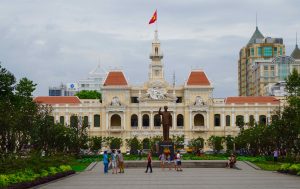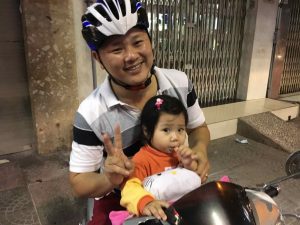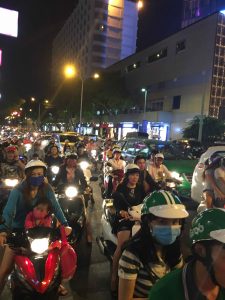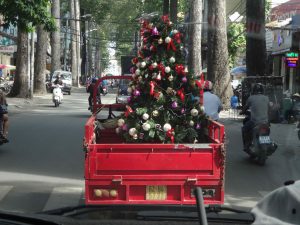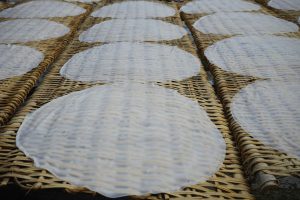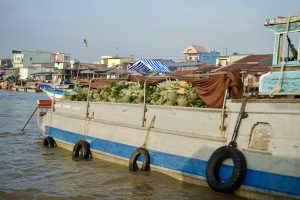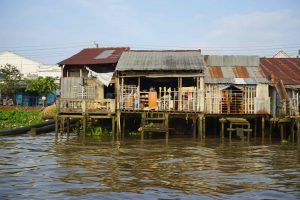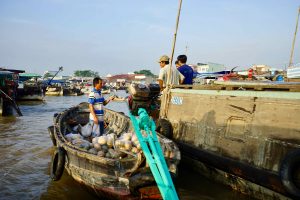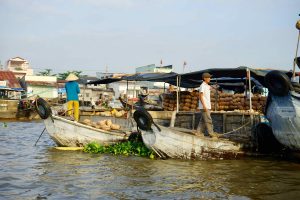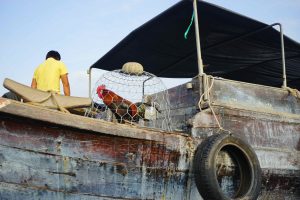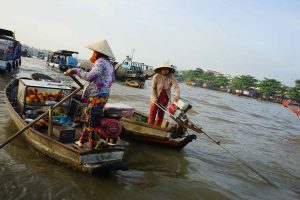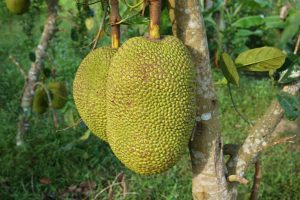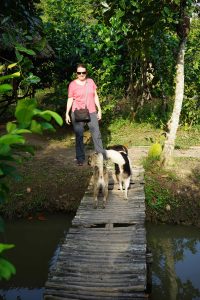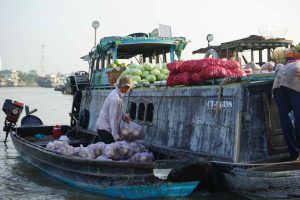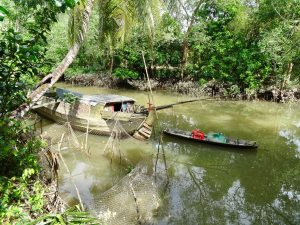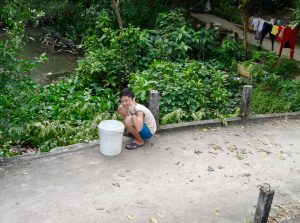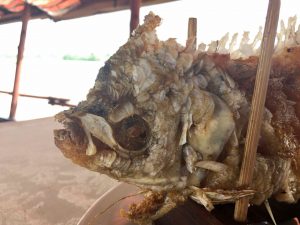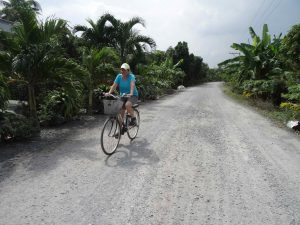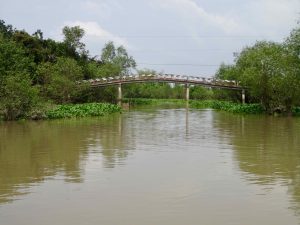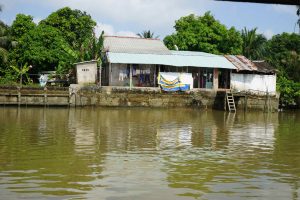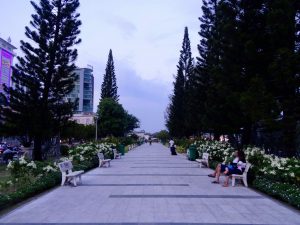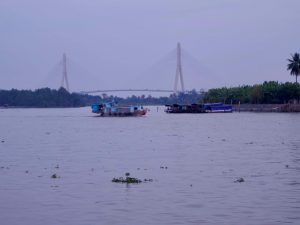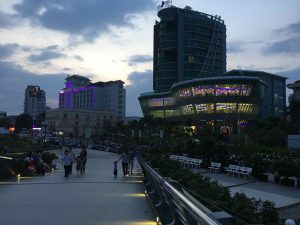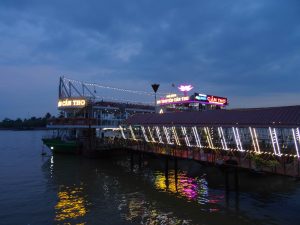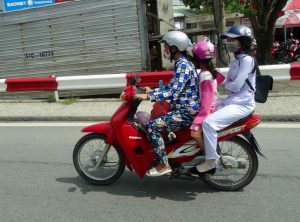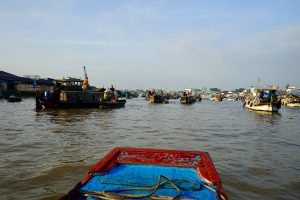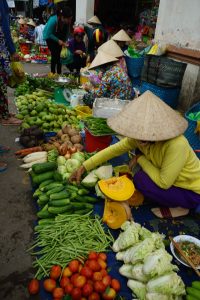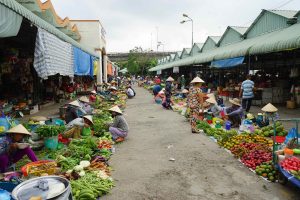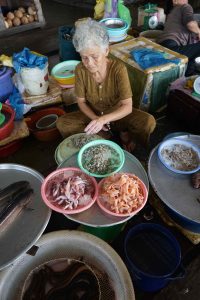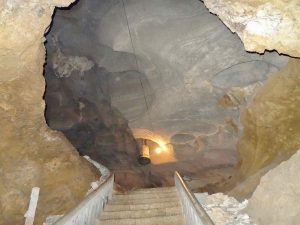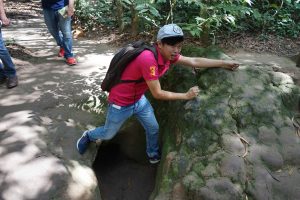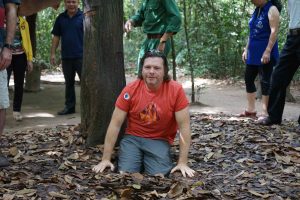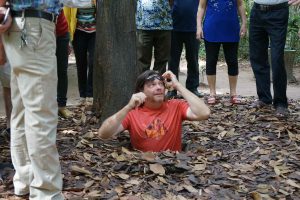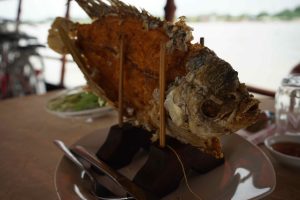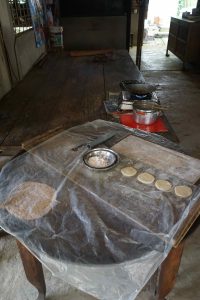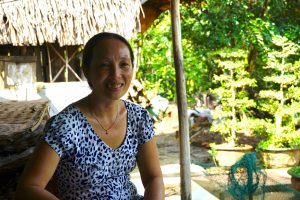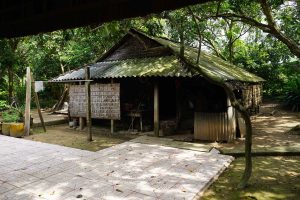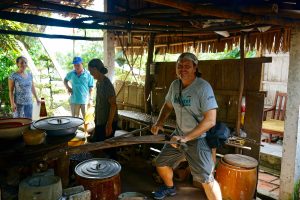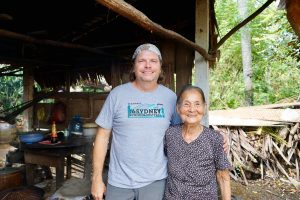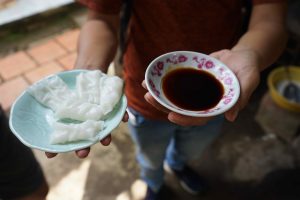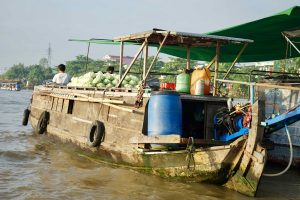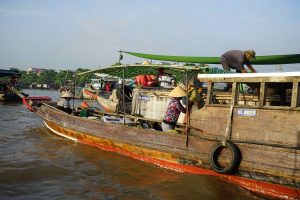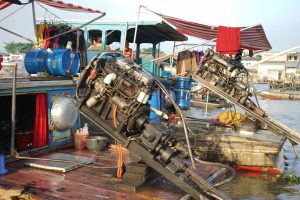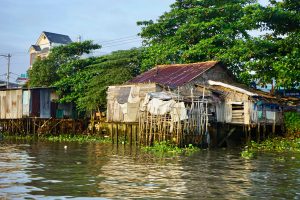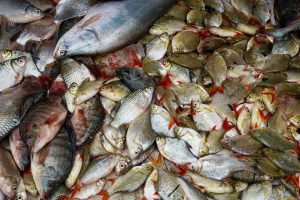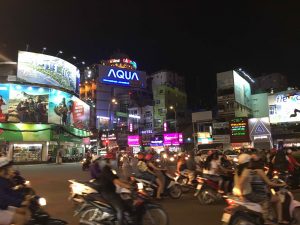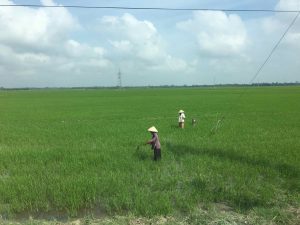We arrive in Hoi Chi Minh City, formerly Saigon, late in the afternoon just in time to enjoy rush hour in this bustling city of over 10 million people and 6.5 million motor bikes! The traffic of mostly scooters is at a standstill near our hotel.
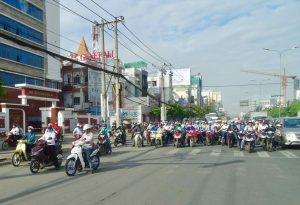 We are staying right in the city center at the Alagon Hotel. The area is filled with restaurants, shops and scooter repair shops, lol. The hotel is newer, nice, comfortable and modern.
We are staying right in the city center at the Alagon Hotel. The area is filled with restaurants, shops and scooter repair shops, lol. The hotel is newer, nice, comfortable and modern.
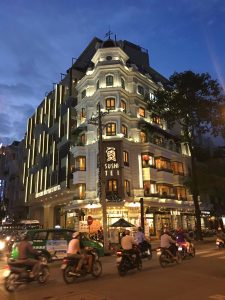 For dinner we eat at an Asian smorgasbord of sorts, Nha Hang Ngon. Cuisines include Japanese, Korean, Chinese, Thai and, yes, of course, Vietnamese. I went for sushi, Tracey for the Thai curry chicken. “When in Rome”, lol. All very good in a very cool setting, part inside, outside, with gardens and neat architecture. We call it an early evening and head back for some sleep in prep for our full day of touring tomorrow.
For dinner we eat at an Asian smorgasbord of sorts, Nha Hang Ngon. Cuisines include Japanese, Korean, Chinese, Thai and, yes, of course, Vietnamese. I went for sushi, Tracey for the Thai curry chicken. “When in Rome”, lol. All very good in a very cool setting, part inside, outside, with gardens and neat architecture. We call it an early evening and head back for some sleep in prep for our full day of touring tomorrow.
Our first, full day in Hoi Chi Minh City (HCMC) starts with a tour of Cu Chi, the maze of tunnels made infamous during the Vietnam War. Its best to make the visit in the mornings because of the heat, even in Vietnam’s winter months. Ninety two is forecast for this cold winter day, just a couple of days before Christmas. Two seasons here they say, “hot and hotter”…feels like Florida!
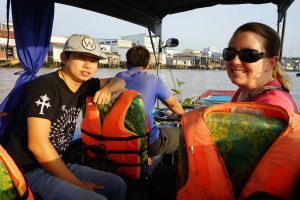 Our wonderful guide is Phong, a great sense of humor and excellent guide! He describes to us how much Vietnamese in general love America. Over one million went to the airport to see President Obama arrive this past year.
Our wonderful guide is Phong, a great sense of humor and excellent guide! He describes to us how much Vietnamese in general love America. Over one million went to the airport to see President Obama arrive this past year.
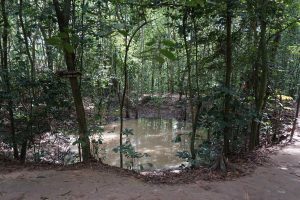
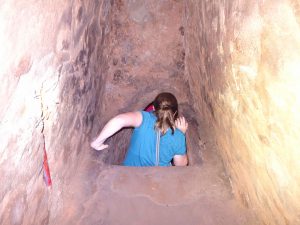
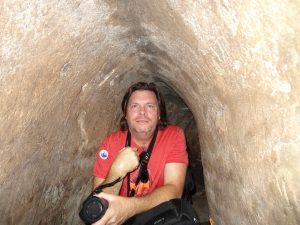 At Cu Chi there are over 300 kilometers of tunnels. A small percentage were built from 1945 to 1954, but the majority during the Vietnam war. During the Indochina war, the small network of tunnels were used to store items and avoid bombings, but during the Vietnam war, many lived here. The area received more than 500,000 tons of bombs mostly dropped from B-52s. Most of the craters were filled in but some remain.
At Cu Chi there are over 300 kilometers of tunnels. A small percentage were built from 1945 to 1954, but the majority during the Vietnam war. During the Indochina war, the small network of tunnels were used to store items and avoid bombings, but during the Vietnam war, many lived here. The area received more than 500,000 tons of bombs mostly dropped from B-52s. Most of the craters were filled in but some remain.
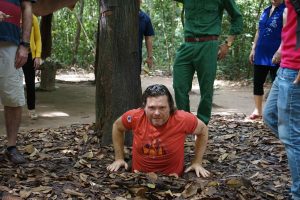
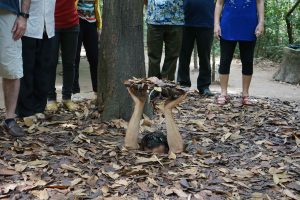
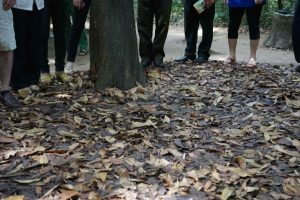
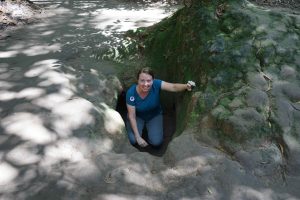 We are able to examine the system of tunnels. I narrowly fit in one of the original entrances. Yes, I have been eating a lot but the entrance is built for Vietnamese sizes. Later, we climb through a few meters of the tunnel system, hunched over almost needing to crawl. The Vietnamese are generally much smaller than Westerners so the entrances and size of the tunnels were purposefully made smaller. I discovered that I may be a bit claustrophobic on this trip!
We are able to examine the system of tunnels. I narrowly fit in one of the original entrances. Yes, I have been eating a lot but the entrance is built for Vietnamese sizes. Later, we climb through a few meters of the tunnel system, hunched over almost needing to crawl. The Vietnamese are generally much smaller than Westerners so the entrances and size of the tunnels were purposefully made smaller. I discovered that I may be a bit claustrophobic on this trip!
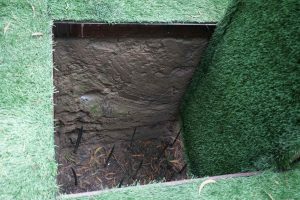
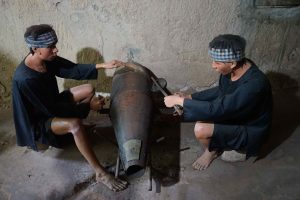 There were simple yet sophisticated booby traps set in the area. We are able to see some of these still remaining as well as displays of others illustrating the mechanics. On site, there are remains, as well as, illustrations of the mechanics to make bombs from unexploded bombs. This was a dangerous occupation as a very high percentage of people dismantling the old bombs were killed during the process.
There were simple yet sophisticated booby traps set in the area. We are able to see some of these still remaining as well as displays of others illustrating the mechanics. On site, there are remains, as well as, illustrations of the mechanics to make bombs from unexploded bombs. This was a dangerous occupation as a very high percentage of people dismantling the old bombs were killed during the process.
There is also a shooting range on site. It is not legal to own guns in Vietnam so many come to experience shooting them, including AK47s. The intermittent sounds of gun shots and rapid fire sure adds to the affect of walking through the area. The thoughts and feelings at this site are sobering, disturbing and depressing knowing all that occurred here.
After the tour we head back to central Saigon for a late lunch. This includes lemongrass chili chicken, more vegetable spring rolls, and beef and onions. They keep feeding us well here in Vietnam!
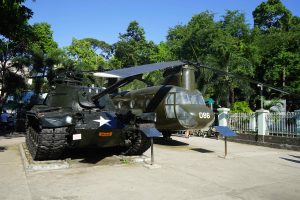 Post lunch we visit the War Remnants Museum. We spend a couple of hours here. While I am sure some of the museum is one sided, there is both an impressive, yet disturbing, photo exhibit that spans three large rooms with mostly US sources. It illustrates the US atrocities that have been well-publicised over many years. It tells many stories of the victims through both Western and Vietnamese photographers.
Post lunch we visit the War Remnants Museum. We spend a couple of hours here. While I am sure some of the museum is one sided, there is both an impressive, yet disturbing, photo exhibit that spans three large rooms with mostly US sources. It illustrates the US atrocities that have been well-publicised over many years. It tells many stories of the victims through both Western and Vietnamese photographers.
As we spend more and more time viewing the photographs and stories, we become more and more nauseated. There is an extensive exhibit of photos and stories on the impacts of “agent orange” which are still negatively impacting the country and its people today. It is difficult to hold back tears here whether you supported the Vietnam War or not. The museum certainly is powerful in conveying the brutal effects of war, particularly on civilians. As we leave the exhibit our guide spends time trying to console our moods.
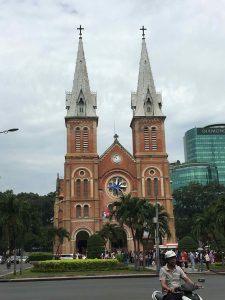
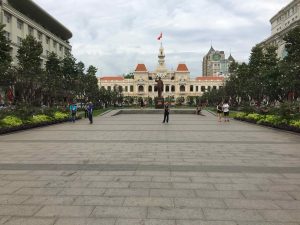 On a lighter note, we take a spin past City Hall on the way back to our hotel. It is closed because of a function. It is actually a bit more modern, at least 70’s style, as it was built near the end of the Vietnam War. We also go by the Notre Dame Cathedral which is impressive, built in 1880.
On a lighter note, we take a spin past City Hall on the way back to our hotel. It is closed because of a function. It is actually a bit more modern, at least 70’s style, as it was built near the end of the Vietnam War. We also go by the Notre Dame Cathedral which is impressive, built in 1880.
Exploring the Mekong Delta
We head out at 8 am on our way to the Mekong River. We drive about two and a half hours south of Saigon. The drive takes us through some rice farm areas and several smaller towns.
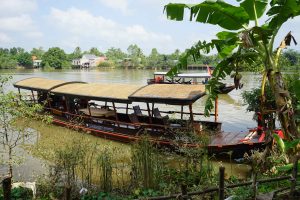 We pick up a local boat on the Mekong that takes us on a short ride to an island in the Mekong. The island has virtually no tourists, so everyone here is interested in our visit, are very friendly and love saying hello.
We pick up a local boat on the Mekong that takes us on a short ride to an island in the Mekong. The island has virtually no tourists, so everyone here is interested in our visit, are very friendly and love saying hello.
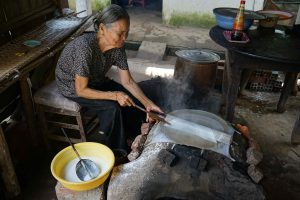 Here we meet some locals and get to see their way of life. The simple life will surely wane here as the years go by and the more modern infiltrates. On our first stop, at one home, we are able to practice our rice paper making skills . We are learning from the master. Phan is 80 years young and still works. Her daughter, Ms. Hai tells us as long as her mother is working the family knows she is feeling well! She first demonstrates to us how to make the rice paper.
Here we meet some locals and get to see their way of life. The simple life will surely wane here as the years go by and the more modern infiltrates. On our first stop, at one home, we are able to practice our rice paper making skills . We are learning from the master. Phan is 80 years young and still works. Her daughter, Ms. Hai tells us as long as her mother is working the family knows she is feeling well! She first demonstrates to us how to make the rice paper.
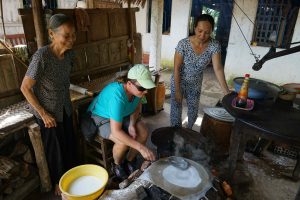
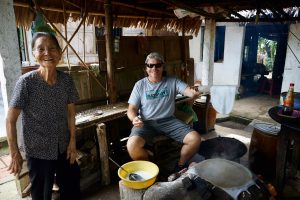 Tracey follows her lead, then it is my turn. I must say rice paper turned out pretty well, a little on the smaller side. But I did have the benefit of watching Tracey make hers first. Again we get to eat our own cooking!
Tracey follows her lead, then it is my turn. I must say rice paper turned out pretty well, a little on the smaller side. But I did have the benefit of watching Tracey make hers first. Again we get to eat our own cooking!
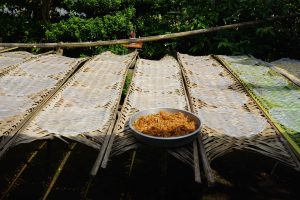
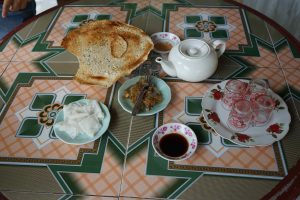 We move over to a table area where the rice paper is being dried. We drink green tea, along with rice crackers and mut. The mut is delicious, a bit like a jam, I suppose, made from dried banana, green papaya, pineapple, ginger, peanuts and some sugar (of the brown variety) for color.
We move over to a table area where the rice paper is being dried. We drink green tea, along with rice crackers and mut. The mut is delicious, a bit like a jam, I suppose, made from dried banana, green papaya, pineapple, ginger, peanuts and some sugar (of the brown variety) for color.
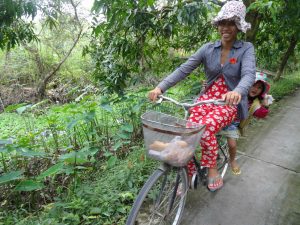
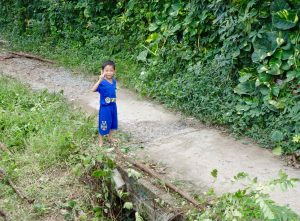 Here we pick up some bikes that were onboard our boat. We travel around the village and island along a narrow concrete path. We meet some scooters, bikes and children along the way that love saying hello to us, except for maybe a few shy school girls.
Here we pick up some bikes that were onboard our boat. We travel around the village and island along a narrow concrete path. We meet some scooters, bikes and children along the way that love saying hello to us, except for maybe a few shy school girls.
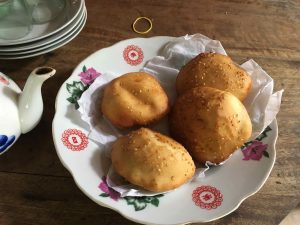
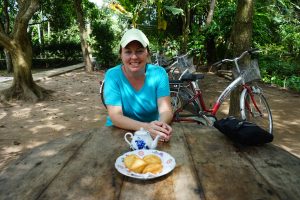 Our next stop is at a village home where some fresh Banh Tu is being prepared. They are made with a tapioca flour, some bread flour, peanut oil and a touch of baking soda…then fried in a wok. They are delicious and taste a bit like a sugar doughnut that my mother used to make.
Our next stop is at a village home where some fresh Banh Tu is being prepared. They are made with a tapioca flour, some bread flour, peanut oil and a touch of baking soda…then fried in a wok. They are delicious and taste a bit like a sugar doughnut that my mother used to make.
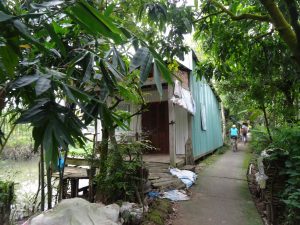
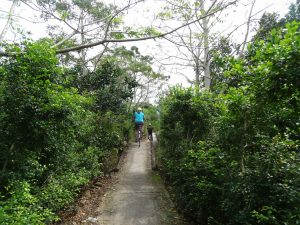 We make our way around the island a bit further on the bikes, crossing many small narrow bridges along the way. The scooter drivers are a bit more forgiving here, yielding and using their horns less.
We make our way around the island a bit further on the bikes, crossing many small narrow bridges along the way. The scooter drivers are a bit more forgiving here, yielding and using their horns less.
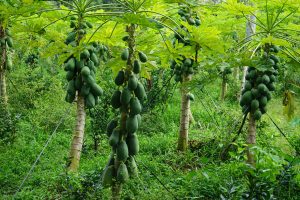 The island is filled with many small plantations with various types of fruits, guava, lychee, banana, mango, jack fruit and others.
The island is filled with many small plantations with various types of fruits, guava, lychee, banana, mango, jack fruit and others.
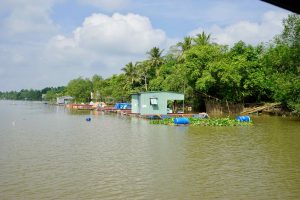
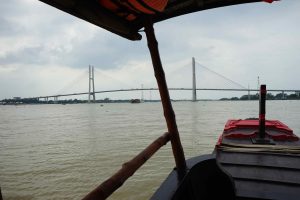 We arrive back at the boat and our journey continues down the Mekong. We pass by many boats hauling various goods, fish farms, fisherman and brick factories. Yes, some of the original or traditional brick factories still are in business, but may not be able to compete with the newer, more efficient and higher standard brick manufacturers for much longer.
We arrive back at the boat and our journey continues down the Mekong. We pass by many boats hauling various goods, fish farms, fisherman and brick factories. Yes, some of the original or traditional brick factories still are in business, but may not be able to compete with the newer, more efficient and higher standard brick manufacturers for much longer.
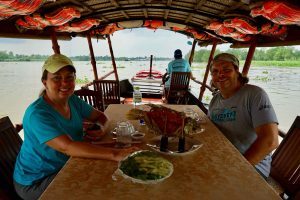 Our guide warned us the day before about the wonderful lunch that would be served on the boat. He had cautioned us not to eat a big breakfast. As we boat down the Mekong, we dine on a spectacular meal all freshly prepared right on the boat.
Our guide warned us the day before about the wonderful lunch that would be served on the boat. He had cautioned us not to eat a big breakfast. As we boat down the Mekong, we dine on a spectacular meal all freshly prepared right on the boat.
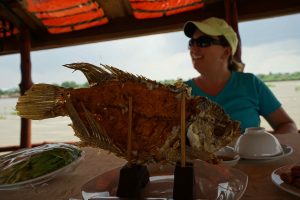
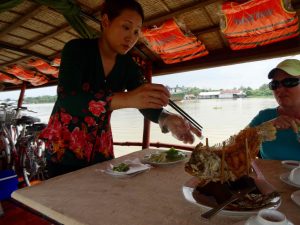 Served right out of the cooker is the Mekong delicacy, the Elephant Ear Fish that is rolled into rice paper with various greens. We also have fried spring rolls, papaya salad with seafood, stewed pork and a seafood soup. Of course, fresh fruit for dessert. The fresh fruit served on the boat includes lychee, pineapple, jack fruit, hairy fruit and bananas. This ranks up there as one of our best of many meals in Vietnam, so far. And you cannot beat the surroundings of the boat cruising on the Mekong River.
Served right out of the cooker is the Mekong delicacy, the Elephant Ear Fish that is rolled into rice paper with various greens. We also have fried spring rolls, papaya salad with seafood, stewed pork and a seafood soup. Of course, fresh fruit for dessert. The fresh fruit served on the boat includes lychee, pineapple, jack fruit, hairy fruit and bananas. This ranks up there as one of our best of many meals in Vietnam, so far. And you cannot beat the surroundings of the boat cruising on the Mekong River.
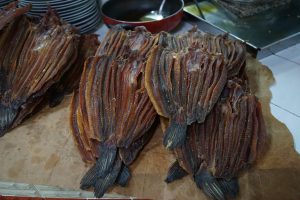
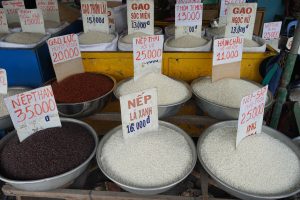
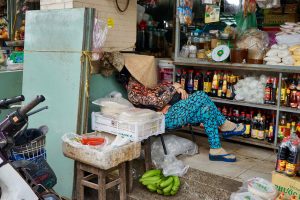
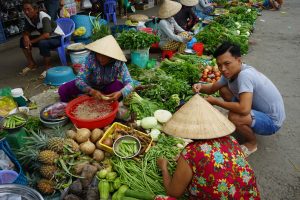 Our afternoon winds down with a walk through the town of Sadec and the local markets. We are the only tourists in this local market, which sells its many fruits and vegetables, to fish and meat, to many kinds of rice.
Our afternoon winds down with a walk through the town of Sadec and the local markets. We are the only tourists in this local market, which sells its many fruits and vegetables, to fish and meat, to many kinds of rice.
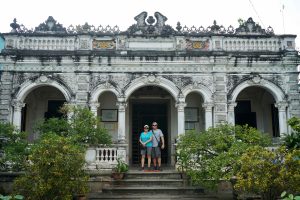 We stop at the Huynh Thuy Le house built in the 1800s. It was made famous by the novel The Lover by Marguerite Duras. The unique home was once owned by Mr. Huynh Thuy Le, who is believed to be the male character in the novel. The home is a combination of French, Vietnamese and Chinese architecture.
We stop at the Huynh Thuy Le house built in the 1800s. It was made famous by the novel The Lover by Marguerite Duras. The unique home was once owned by Mr. Huynh Thuy Le, who is believed to be the male character in the novel. The home is a combination of French, Vietnamese and Chinese architecture.
Our afternoon winds down at a 300 year old pagoda in Sudec, the Cao Dai temple. Our driver picks us up here and we make about a ninety minute trip through farmland and small villages to Can Tho where we stay for the night.
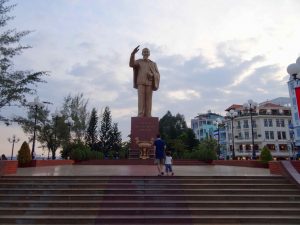
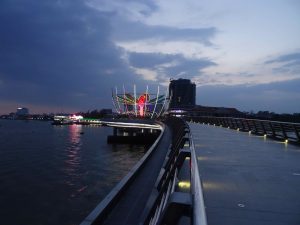 Can Tho, located on the Hua River, is the fourth largest city in Vietnam with over one million people. We take a walk along the river as night falls. The beautiful park along the river features the large image of Ho Chi Minh. Many folks are enjoying the park on this Friday evening leading up to Christmas weekend. We have some dinner, our seemingly go to Western meal of pizza to take our break from Vietnamese cuisine.
Can Tho, located on the Hua River, is the fourth largest city in Vietnam with over one million people. We take a walk along the river as night falls. The beautiful park along the river features the large image of Ho Chi Minh. Many folks are enjoying the park on this Friday evening leading up to Christmas weekend. We have some dinner, our seemingly go to Western meal of pizza to take our break from Vietnamese cuisine.
Christmas Eve
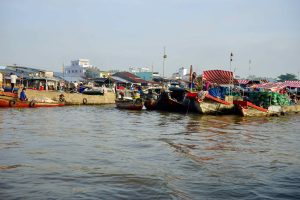
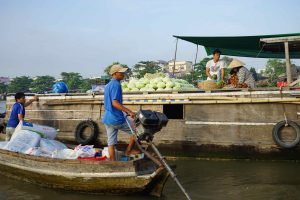 It’s an early morning, about 6 am as we board a boat to head to the local Cai Rang floating market in Can Tho. This unique market, literally on the water, is the place where local vendors meet and trade by boat starting at 4 am and wrapping up around 10 am.
It’s an early morning, about 6 am as we board a boat to head to the local Cai Rang floating market in Can Tho. This unique market, literally on the water, is the place where local vendors meet and trade by boat starting at 4 am and wrapping up around 10 am.
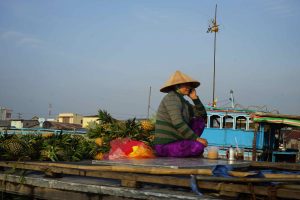
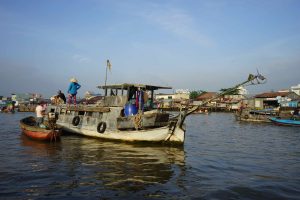 The boats sell mostly food. The product that is being sold is typically hoisted on a pole to indicate to others the particular goods they are selling. There are dozens of boats meeting at one central location on the river.
The boats sell mostly food. The product that is being sold is typically hoisted on a pole to indicate to others the particular goods they are selling. There are dozens of boats meeting at one central location on the river.
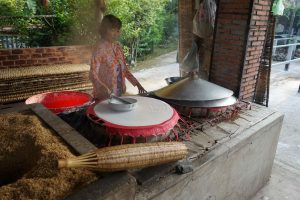 After weaving our boat through the market, we journey downstream to a rice noodle factory. A similar process is used as we used the day before to make our rice paper. These, however, are mixed with tapioca and a bit thicker for making rice noodles.
After weaving our boat through the market, we journey downstream to a rice noodle factory. A similar process is used as we used the day before to make our rice paper. These, however, are mixed with tapioca and a bit thicker for making rice noodles.
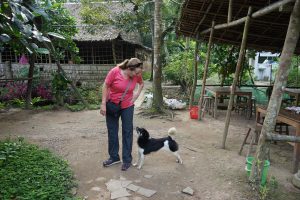
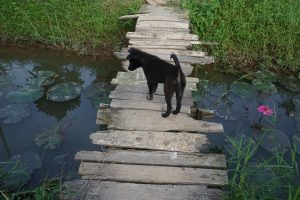
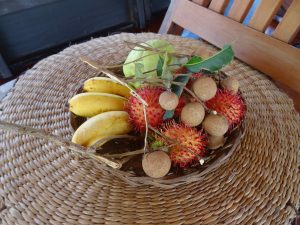 From here we visited a small fruit plantation. We stroll through the farm led by some local dogs that seem to enjoy showing us around. We sample a variety of the fresh fruit including jack fruit, mango, hairy fruit, apple, dragon fruit and sapodilla. We are certainly getting some good vitamins from all this great fresh fruit.
From here we visited a small fruit plantation. We stroll through the farm led by some local dogs that seem to enjoy showing us around. We sample a variety of the fresh fruit including jack fruit, mango, hairy fruit, apple, dragon fruit and sapodilla. We are certainly getting some good vitamins from all this great fresh fruit.
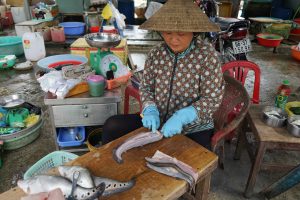
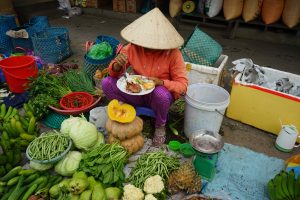 Our last stop on this early morning venture takes us to another local fish, meat and vegetable market.
Our last stop on this early morning venture takes us to another local fish, meat and vegetable market.
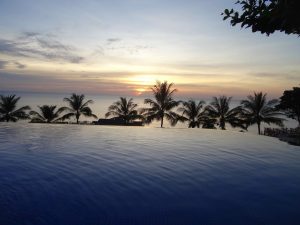
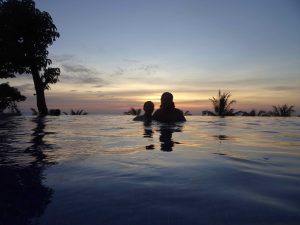 We take about a two hour trip to the southern tip of Vietnam to Rach Gia. This is where our visit to this most unique spot in the world, the Mekong Delta ends, and our ferry trip to the beautiful Phu Quoc island of Vietnam begins! We spend Christmas Eve, Christmas Day and a few more must needed, restful days on Phu Quoc!
We take about a two hour trip to the southern tip of Vietnam to Rach Gia. This is where our visit to this most unique spot in the world, the Mekong Delta ends, and our ferry trip to the beautiful Phu Quoc island of Vietnam begins! We spend Christmas Eve, Christmas Day and a few more must needed, restful days on Phu Quoc!
And a few more pics!
